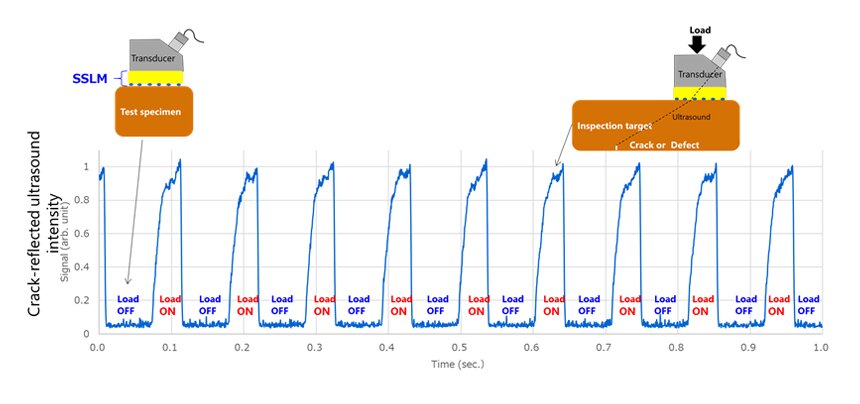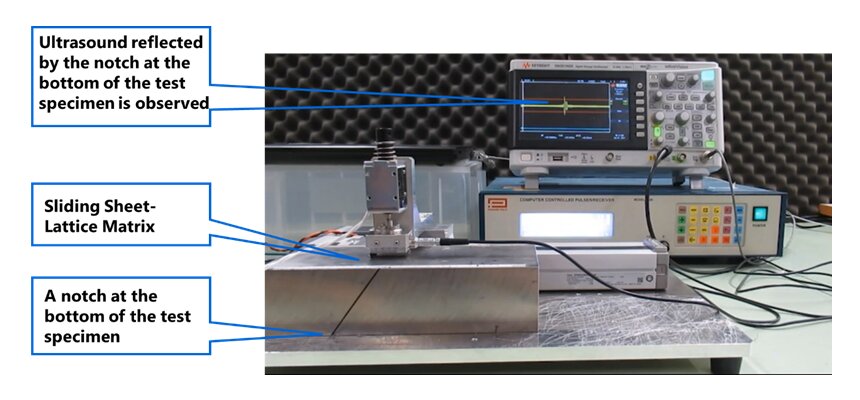
Fig. 1: Composition of the sliding sheet-lattice matrix. Credit: Toshiba Corporation
Toshiba Corporation has developed a sliding sheet-lattice matrix (SSLM) for ultrasonic nondestructive testing in infrastructure maintenance and inspections. The developed SSLM does not require the application of a liquid couplant, such as the gel applied to human bodies for ultrasonic examinations during health checkups, and furthermore combines high performance for passing ultrasonic waves (ultrasonic propagation) with smooth device operability.
Nondestructive testing is an inspection evaluating internal defect and its form or size in an object without damaging it, and ultrasound, which is harmless to the human body, is widely used in such inspections. Liquid or gel couplant are often used in ultrasonic inspections, especially when inspecting the human body, because they both provide high levels of ultrasonic propagation and smooth operations.
However, in the field of infrastructure maintenance and inspection, liquids can seep into the interior of inspection targets, leading to failure or deterioration of the applied structures or equipment. Minimizing such effects requires additional work, so applications to infrastructure now also uses adhesive sheets of solid couplant, but there is generally a trade-off between ultrasonic propagation and smooth operations, leading to issues such as increased work times.
Toshiba has developed SSLM comprising a proprietary soft sheet and lattice material to realize both ultrasonic wave propagation and smooth operability. The lattice material allows low-friction movement over structure and equipment surfaces when changing inspection positions, and when inspecting, applying a load to press the SSLM against the object that is the target of an inspection allows propagation of ultrasonic waves, giving it rapid response characteristics.
Ultrasonic nondestructive testing requires taking measurements from many locations following the surface of the inspected object, and thus use of the developed SSLM should result in significant time reductions compared with the inspection times seen when using conventional adhesive sheets. In addition, compared with conventional ultrasonic nondestructive inspection methods using a liquid couplant, SSLM eliminates the need for masking areas outside of the inspection area before the inspection and removing applied liquid couplant after inspections, thereby contributes to improved efficiency and automation of maintenance and inspections. Furthermore, it enables be applied to objects that were previously difficult to apply, due to the difficulty of removing liquids.
Toshiba presented details of this development at the 43rd Symposium on Ultra Sonic Electronics.

Fig. 2: Time dependence of crack-reflected ultrasound intensity within a test specimen. Credit: Toshiba Corporation
Background of the development
The global market for nondestructive testing for structures and equipment in industrial plants and infrastructure is projected to grow at a compound annual growth rate of 4.7% from 3.1 trillion yen in fiscal 2018 to 4.9 trillion yen by 2028. In response to the challenges of aging infrastructure and labor shortages, there are ongoing worldwide efforts toward improving the processes of nondestructive testing and making them more efficient. Nondestructive testing often employs ultrasonic waves, particularly in the simple and convenient pulse–echo method, which transmits ultrasonic pulses and receives waves reflecting from defects.
Ultrasonic waves tend to reflect between materials with different acoustic impedance. Air has a very low acoustic impedance compared with the sensors (transducers) used to transmit and receive ultrasonic waves or the objects being inspected, so inspections will be difficult if any air is present between them. Therefore, gel-like liquid couplant is generally used to propagate ultrasonic waves to the object being inspected, such as in ultrasonic inspections of the human body. Similarly, couplant is also required when performing infrastructure maintenance and inspections.
Applying a couplant allows ultrasonic waves to propagate to the object being inspected and makes transducer operations smoother, but liquid can potentially seep into the inspected target's interior, leading to failure or deterioration of structures and equipment. To minimize such possibilities, it is necessary to mask areas other than the inspection area before the inspection and remove the applied liquid couplant after the inspection, complicating inspection tasks and making it difficult to improve efficiency. It is also difficult to use liquid couplant on highly absorbent or porous materials, and in some cases, applying a couplant may defect the structure or equipment itself, making it impossible to use.

Fig. 3: Example of continuous inspection. Credit: Toshiba Corporation
To address these challenges, the infrastructure sector has recently started to use adhesive sheets of solid couplant. These adhesive sheets are polymer elastic materials such as silicone rubber sheets. Because they are solid, they are less likely to cause wear that will deteriorate the inspected object. However, their high adhesiveness prevents smooth transducer operations, and sheets must be peeled off and reapplied each time the inspected area changes, so operability issues remain.
Amidst these circumstances, there has been a need for solid couplant that realize both ultrasonic propagation and smooth operations.
Features of the developed technology
In response, Toshiba developed SSLM that improves operability while maintaining ultrasonic wave propagation to the inspection target like a liquid couplant (Fig. 1). SSLM is a unique combination of a soft sheet with a lattice material. The air layer between the inspection target and the transducer is removed to maintain ultrasonic wave propagation, by a soft sheet-like material that can freely change its shape and closely adhere to surfaces accommodates any unevenness on the inspection target and transducer surface. The underside of that matrix is a material having low friction with the inspection target.

Fig. 4: Tests of flaw detection using the sliding sheet-lattice matrix. Credit: Toshiba Corporation
Attaching the transducer to the SSLM allows it to be moved smoothly across the surface being inspected, and applying a load presses the sheet against the inspection target, pushing the lattice material into the sheet, thus eliminating the air layer and allowing adherence to the target during inspection. When the load is released after the inspection, the pressed-in lattice matrix returns to its original state, allowing the transducer to move smoothly again.
In Toshiba-performed inspections of stainless steel, which are often applied to infrastructure structures, when using SSLM the response time from the application of load until ultrasonic waves sufficiently propagated into the inspected object was less than 50 ms, confirming the system's high responsiveness compared with adhesive sheets (Fig. 2).
When the load is released, the SSLM quickly returns to its original state, allowing smooth movement. The matrix can be easily moved along the surface to be inspected, allowing inspections at multiple points in a short time, and thus should allow for significantly reduced inspection times (Fig. 3). Furthermore, unlike when using liquid couplant, no masking before inspections or removal of couplant after inspections is required, simplifying maintenance and inspection tasks, reducing inspection times, and contributing to the future automation of maintenance and inspections.
Future prospects
Toshiba expects the developed SSLM to be applied not only in upgrades to the maintenance and management of aging infrastructure, but also to the maintenance and inspection of large structures such as windmills, airplanes, and other large equipment with rotating parts for which it is difficult for maintenance personnel to enter and inspect. Toshiba will continue to develop related ultrasonic nondestructive inspection technologies, aiming for early commercialization.
Source: https://techxplore.com/news/2022-11-sheet-lattice-matrix-ultrasonic-nondestructive-require.html








 Focus on us
Focus on us